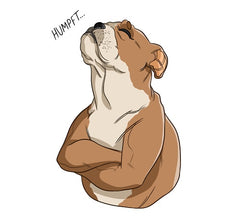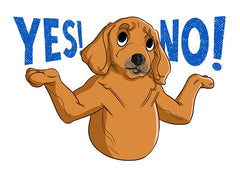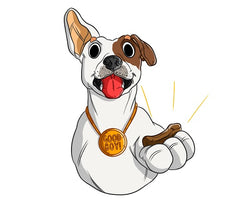Maybe you've never trained a puppy before or maybe you have realized that you could have done better last time around. Whether you're asking, "how long does it take to train a puppy", how do I house train a puppy, or how do I train a puppy, we've got you covered in this post.
Training a puppy covers more than you may think

Training a puppy spans teaching them to go to the bathroom outside to behaving well in the house to interacting well with people to learning commands.
They can learn different steps of training in set periods of time. For instance, most puppies can be trained to go to the bathroom only outside in 4 to 6 months.
Do be aware that even puppies can have learned bad behaviors that need to be undone. If they were born in another environment, outside or in someone else's home, you may not be starting with a clean slate and the training may take more time or be more difficult.
Training your puppy to be a happy, well-adjusted dog that gets along well with people will take their entire puppyhood, three years, and will need to be maintained throughout the rest of their lives. You can't just teach them to do something a certain way and then expect them to always act on it no matter how you act.
The Beginning
You will begin with the basics of living in the home, not peeing or pooing in the house, and not destroying everything.
Designate chunks of time throughout the day to training the puppy, one in the morning, one at lunch, and one in the evening. Or at least the morning and the evening.
Before even beginning to explain steps, let's go to two fundamental aspects, reinforcement and consistency. Without them, the steps won't matter.
Reinforcement

Whatever you intend to teach your puppy, you have to be dedicated to reinforcing. The puppy will need routine, and the response to good behavior that you want repeated should be very distinct from bad behaviors that you want to discourage. You don't want your puppy confused about what you want or for your responses to seem meaningless.
Every member of the household has to uphold the training as well. Otherwise, it will look like you are the only person who minds bad behaviors or cares about the good behaviors. If you've started teaching the puppy something, when you are not around, your spouse, children, and roommates need to acknowledge if the puppy did what you asked or did something you are trying to discourage it from.
Consistency
There is an important similarity and an important difference between reinforcement and consistency. Both reinforcement and consistency keep your training clear and important in the puppy's mind. But consistency is what gives reinforcement its effectiveness. It is so important that it must be stated separately.
Imagine that earlier that day you tried to teach the puppy not to chew on the furniture or your shoes. The first time or two that you see it, you tell the puppy to stop, but later that day you are busy and you do nothing. The puppy knows you see it or hear it, and that you're doing nothing. This makes your command meaningless. Either the puppy doesn't understand why it matters one time and doesn't the next, or the puppy will learn that it can get away with the activity sometimes. It can just keep pressing you, waiting for the opportunities when it can do it without repercussions.
Now life is messy. It isn't realistic to think you can always respond to the dog's bad behavior, but it should be such a rare occurrence that the puppy won't consider it worthwhile to press you.
Reinforcement and consistency play a huge part in how quickly your puppy learns. It may never be reliable if you aren't consistent, and the more of a routine you build and the more consistent you are, the quicker the puppy will learn what you want and understand how important it is to behave.
Yes and No

Yes and no are common, easy ways to reinforce good behaviors. When the puppy does something good, you say yes, when the puppy does something bad, you say no.
Now you have to teach it that that means something. Of course, puppies aren't born understanding yes and no.
Teach the puppy that yes means you are pleased with it by petting it, speaking kindly to it, giving it a treat, or doing something else it likes.
Teach the puppy that no means something is unacceptable by physically stopping it from engaging in the bad behavior.
Don't confuse them by saying no and cuddling them while moving them. Just pick it up and move it or take the object that it is wrongly interacting with away.
Also, make sure you spend quality time with your puppy, even giving higher priority to more demanding breeds, so it doesn't actually get more attention by being bad.
House Training
House training, or potty training, is not exactly difficult, but it does require planned structure from you. Not only do you have to take the puppy outside, but you have to do so regularly enough that it isn't forced to pee or poo in the house, or isn't going to do so before you have a chance to take it out and cause an unpleasant and confusing situation for both of you.
The puppy can be potty trained in only 2 weeks, depending on the puppy, when you start, and whether it's had time to develop poor behaviors.
12 to 16 weeks is the recommended time to start house training a puppy. Before that time, it doesn't have physical control of its bladder and trying to train it will be pointless and upsetting.
You or someone in your household should take the puppy out regularly, without waiting for signs that it has to go. It hasn't learned to show you it needs to go yet.
Take the puppy outside:
- when you wake up
- after it eats(you'll have to feed it on a schedule to do this)
- after it gets up from a nap
- before leaving it alone for a period of time
- before going to bed at night
If none of these things occurs in two hours' time, take it outside anyway.
It helps to take the puppy to the same spot each time, or to any place it previously went, because smelling where it went in the past will prompt it to go.
Stay with the puppy the whole time it's outside or you may not know it went. You also can't immediately praise or reward it.
Petting, praising, or simply taking it for a walk is sufficient reward.
If the puppy starts peeing or pooing in the house, pick it up and take it outside. Note the time and take the puppy out again in two hours.
Know that puppies from smaller breeds may need to go outside more frequently than other breeds because their bladders are smaller and their metabolisms are faster.
The more of a routine you set, the more likely it will be that the puppy will learn quickly.
Biting
It is reasonable to expect it to take 3 to 4 weeks for your puppy to learn not to bite.
Give your puppy plenty of healthy ways, otherwise known as toys, to exercise its need to chew and use its mouth.
If it bites you, say "Ouch!" strongly and refuse to play or interact with it for a few seconds. Get family members to do the same.
You may want to keep smaller children away from the puppy while it is learning not to bite.
Herding dog breeds may have more difficulty learning not to nip. This is different from biting in general because they will nip along with other herding behaviors. If you struggle to teach your dog not to do this, you may need to have it professionally trained and possibly keep it away from kids and other animals.
The Leash
It can take a puppy a long time to learn how to walk on a leash correctly.
Start training your puppy to walk on a leash very early. You can start by getting it used to having a collar around its neck. Just slip one on and let it wear it for a little while. Eventually, you'll want to attach the leash and then start taking it out in your yard on the leash.
After it has been vaccinated, you can start walking it in areas where it can encounter other dogs and where other dogs have been. This gives it the challenge to walk on sidewalks and other areas where it has to learn to walk in a straight line and to stay close to you.
Puppies get tired faster than older dogs. Don't push it to walk after it starts getting tired.
Socialization
Socialization is an important part of puppy training. After it has been vaccinated, you should ensure it gets daily opportunities to be around people and other dogs and for you to continue its training in these environments.
Crate training
Some puppies like or don't mind being in their crate. They'll take right to it. 2 to 4 weeks is the average time it takes a puppy to be crate trained, but some may take months and extra training.
The Ongoing Saga
So, how long does it take to train a puppy? You will always be training your puppy; it just becomes maintenance rather than building. If you trained the puppy to not jump on people, but it finds itself inspired to do it several years down the line, you have to reinforce the idea that it is bad just like you did when it was little or the next thing you know, you'll have a regular jumper on your hands.
How CBD Oil Might Help You Train Your Puppy
One reason someone may be asking, "how long does it take to train a puppy," may be because they're wondering why it's taking so long. Is this normal? What's wrong?
There may be issues that make training your puppy more difficult than is normal. Trying to force a puppy to learn around these issues will be ineffective and upsetting.
Puppies and dogs may struggle with training because of other problems like anxiety. Anxiety and depression cause behavior problems in dogs. They are crying out for help. Trying to train over this won't help.
And sometimes no matter how well you trained your puppy, diarrhea can negate all your training. If they can't hold it, they can't hold it, no matter what they've been taught.
CBD oil might address issues impairing your puppy or dog's trainability by:
- alleviating stress
- boosting mood
- encouraging a healthy sleep pattern(if something is impairing their ability to sleep)
- managing diarrhea
- reducing inflammation
- alleviating pain
Using CBD Oil
CBD oil comes in several forms so you can get what your dog will like and what will be suitable for their needs.You can buy your dog:

- oil tinctures
- extract concentrates
- capsules
- treats
- topicals
Puppies have special dosing requirements. You will have to buy capsules or treats that are specifically made for puppies or break apart the treats to be suitable. Extract concentrates and oil tinctures will probably be better for puppies because you can get very specific with dosing. Topicals are great for localized issues, like if the puppy hurt itself and lotion might make its legs less inflamed and painful.
Dosing CBD Oil
CBD Dosing depends on the weight, size, age, and overall health of the puppy. Give them as tiny amount as possible and you may want to consult a vet before giving it to them.
The ailment you are attempting to help manage with CBD also matters. Some ailments actually respond better to less CBD than larger amounts.
Determine through research, manufacturer recommendations, and/or vet consultation the maximum amount that will be safe for your puppy. Start with a very small dose and gradually increase the dose until you see results or you hit that maximum amount.
If they become sedated, lose their appetite, or develop diarrhea, or their diarrhea worsens, stop giving them CBD oil or cut back as directed by a vet. This means they are getting too much.
Risks Associated with CBD Oil
CBD oil is considered safe. It's becoming a more popular alternative and additional aid for many ailments because it has an extremely low potential for side effects of CBD and risks.
As mentioned in the last section, it's also possible for your puppy to get too much CBD oil.

If your puppy is on medication, speak to the vet before giving them CBD oil. Also, tell the vet you are giving your puppy CBD oil before they give or prescribe them anything. CBD oil impacts the way the liver absorbs medications so the vet's dosing may not be effective or safe unless they can account for CBD oil.
CBD oil does not have FDA approval at this time because it hasn't undergone the required amount of testing yet. It's kind of experimental at this stage. Puppies are particularly vulnerable. If your puppy is ailing, you should have vet care and use CBD oil only as a secondary aid or a primary one if they can't take anything else or the puppy's condition is not too serious. Some vets are supportive of and knowledgeable about the use of CBD oil, but if yours is not and you really want to use CBD oil for your puppy or dog, you might find a holistic vet in or near your area who can help you.
Purchasing CBD Oil
Before purchasing CBD oil for your puppy or dog, you should know the following.
The difference between CBD isolate and full-spectrum CBD
CBD isolate is just cannabidiol while full-spectrum CBD oil contains cannabidiol, other cannabinoids, and other nutrients from the hemp plant. For puppies, many people might prefer the simpler route of using CBD isolate, unless the puppy needs the extra nutrients found in full-spectrum CBD oil. You should probably consult the vet for advice.
Third-party testing
You should read the manufacturer's website to see if they have third-party lab test results for their products. This will help you ensure that the product does contain the amount of cannabidiol you think you're buying for your puppy. Some manufacturers have sold products with less than the advertised amount or none at all.
Origin
Buy CBD oil products made by people who tell you where the hemp was grown. This way you can be sure it came from a country with safe growing practices.
Extraction method
The CO2 extraction method is the safest and purest one, so ensure the company used it by checking their website.
Read the label
Ensure the product you buy contains as few ingredients as possible. This reduces the likelihood that they put something unnecessary or unsafe in the product and makes it easier for you to research what's in it.
Start your CBD oil journey with us here at Innovet. We meet or exceed all of these criteria.
Innovations from Innovet
How long does it take to train a puppy? It can take a shorter amount of time with the wide range of innovative and problem-solving products at Innovet. Make your life and that of your puppy easier here.
If your puppy or dog is struggling with training and nothing seems to fix it, reach out to us to see if we can't create a new product to help your pet.
Sources:
Puppy Behavior and Training - Training BasicsHouse Training Your Puppy
Approved by:
Dr. Sara Ochoa
Doctor of Veterinary Medicine, St. Georges University

Thanks for stopping by!
P.S. We Love You!
Sincerely,
The Innovet Team
Please do not ask for emergency or specific medical questions about your pets in the comments. Innovet Pet Products is unable to provide you with specific medical advice or counseling. A detailed physical exam, patient history, and an established veterinarian are required to provide specific medical advice. If you are worried that your pet requires emergency attention or if you have specific medical questions related to your pet’s current or chronic health conditions, please contact or visit your local/preferred veterinarian, an animal-specific poison control hotline, or your local emergency veterinary care center.
Please share your experiences and stories, your opinions and feedback about this blog, or what you've learned that you'd like to share with others.
















